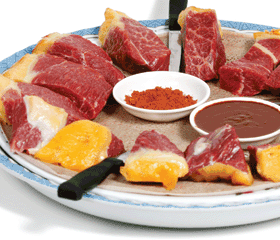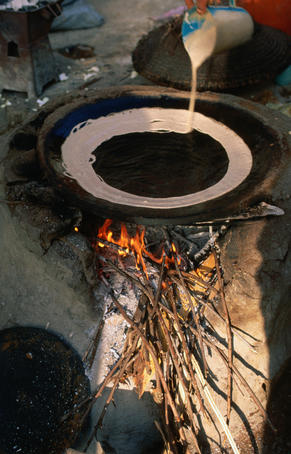22 April 2014
This is an excerpt from the Food & Drink chapter of Lonely Planet’s guide to Ethiopia & Eritrea.
Popular breakfast dishes include enkulal tibs (scrambled eggs made with a combination of green and red peppers, tomatoes and sometimes onions, served with bread), ful (chickpea and butter purée) and injera fir fir(tornup injera mixed with butter and berbere, a red powder containing as many as 16 spices or more). At lunch and dinner the much heralded Ethiopian staples of wat, kitfo and tere sega come out to play with the ever-present injera.
Injera
Just like your first kiss, your first taste of injera is an experience you’ll never forget. It’s the national staple and the base of almost every meal. It is spread out like a large, thin pancake, and food is simply heaped on top of it. An American tourist is said to have once mistaken it for the tablecloth. Occasionally, injera is served rolled up beside the food or on a separate plate, looking much like a hot towel on an aeroplane.

Image by edseloh
Just like your first kiss, most first impressions of injera are not too positive! The overwhelmingly sour taste can be enough to make some people retch (though we hope you didn’t do that on your first kiss!), but give it another few mouthfuls and it’ll start to grow on you. The sour taste contrasts beautifully with the fiery sauces it’s normally served with. Like bread, it’s filling; like a pancake, it’s good for wrapping around small pieces of food and mopping up juices. It’s also much easier to manipulate on the plate than rice and it doesn’t fall apart like bread – all up injera is quite a clever invention, really.

Image by LollyKnit
Although injera may look like old grey kitchen flannel, grades and nuances do exist. With a bit of time and perseverance, you may even become a connoisseur. Low-quality injera is traditionally dark, coarse and sometimes very thick, and is made from millet or even sorghum. Good-quality injera is pale (the paler the better), regular in thickness, smooth (free of husks) and always made with the indigenous Ethiopian cereal tef. Because tef grows only in the highlands, the best injera is traditionally found there, and highlanders tend to be rather snooty about lesser lowland versions.
Wat

Image by Travlr
The ubiquitous companion of injera, wat is Ethiopia’s version of curry and can be very spicy – fortunately the injera helps to temper the heat. In the highlands, bege (lamb) is the most common constituent of wat. Bure (beef) is encountered in the large towns, and figel (goat) most often in the arid lowlands. Chicken is the king of the wat and doro wat is practically the national dish. Ethiopian Christians as well as Muslims avoid pork. On fasting days, and throughout Lent, meat dishes are avoided and various vegetarian versions of wat are available. Kai wat is a stew of meat boiled in a spicy (thanks to oodles of berbere) red sauce. Kai sauce is also used for minchet abesh, which is a thick minced-meat stew topped with a hard-boiled egg – it’s one of our favourites, particularly with aib (like dry cottage cheese). Most Ethiopians seem to be under the impression that all foreigners are terrified of spicy food and so, unless you specifically ask for kai wat, you’ll often be served the yellow coloured alicha wat, a much milder, and really rather dull tasting wat.
Kitfo

Image by stu-spivak
Kitfo is a big treat for the ordinary Ethiopian. The leanest meat is reserved for this dish, which is then minced and warmed in a pan with a little butter, berbere and sometimes tosin (thyme). It can be bland and disgusting, or tasty and divine. If you’re ravenous after a hard day’s travelling, it’s just the ticket, as it’s very filling. A tip? Ask for a heap of berbere on the side. Traditionally, it’s served just leb leb(warmed not cooked), though you can ask for it to be betam leb leb (literally ‘very warmed’, ie cooked!). A kitfo special is served with aib and gomen (minced spinach). In the Gurage region (where it’s something of a speciality) it’s often served with enset (kotcho; false-banana ‘bread’). Kitfo beats (restaurants specialising in kitfo) are found in the larger towns. Another favourite meat dish of ours is siga tibs, which consists of small strips of fried meat served with onions, garlic and spices.
Tere Sega

Image by ILRI
Considered something of a luxury in Ethiopia, tere sega (raw meat) is traditionally served by the wealthy at weddings and other special occasions. Some restaurants also specialise in it. Not unlike butcher shops in appearance, these places feature carcasses hanging near the entrance and men in bloodied overalls brandishing carving knives. The restaurants aren’t as gruesome as they sound: the carcass is to demonstrate that the meat is fresh, and the men in overalls to guarantee you get the piece you fancy – two assurances you don’t always get in the West. A plate and a sharp knife serve as utensils, and awazi (a kind of mustard and chilli sauce) and berbere as accompaniments. Served with some local red wine, and enjoyed with Ethiopian friends, it’s a ritual not to be missed – at least not for red-blooded meat eaters. It’s sometimes called gored gored.
Read more:lonelyplanet.com





